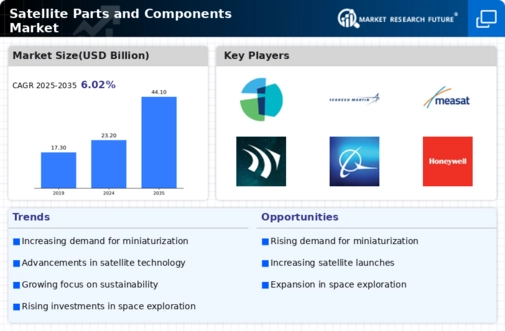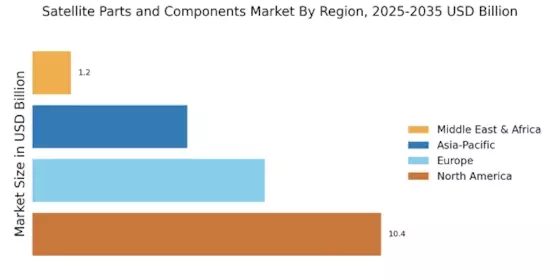Advancements in Satellite Technology
Technological advancements play a pivotal role in shaping the Satellite Parts and Components Market. Innovations such as miniaturization, improved propulsion systems, and enhanced payload capabilities are transforming satellite design and functionality. The introduction of new materials and manufacturing techniques has led to lighter and more efficient components, which are essential for modern satellite applications. For instance, the development of high-performance solar panels and advanced thermal control systems has significantly improved satellite efficiency and longevity. As these technologies continue to evolve, they are expected to drive the demand for specialized parts and components, thereby creating new opportunities for manufacturers and suppliers within the industry.
Growing Investment in Space Exploration
Investment in space exploration is a critical driver for the Satellite Parts and Components Market. Governments and private entities are increasingly allocating resources to explore outer space, leading to a rise in satellite launches and missions. In 2025, the global space economy is anticipated to exceed 400 billion USD, with a substantial portion directed towards satellite development and deployment. This influx of capital is likely to stimulate demand for various satellite components, including propulsion systems, communication devices, and sensors. As exploration initiatives expand, the need for advanced and reliable satellite parts will become more pronounced, presenting lucrative opportunities for industry players.
Regulatory Support for Satellite Operations
Regulatory frameworks are becoming increasingly supportive of satellite operations, which is a key driver for the Satellite Parts and Components Market. Governments are recognizing the strategic importance of satellite technology for national security, communication, and scientific research. As a result, there is a growing trend towards streamlining regulatory processes to facilitate satellite launches and operations. This supportive environment is expected to encourage investment in satellite infrastructure and technology, leading to an increased demand for satellite parts and components. By fostering innovation and reducing barriers to entry, regulatory support is likely to enhance the overall growth prospects of the industry.
Increasing Demand for Satellite Communication
The Satellite Parts and Components Market is experiencing a notable surge in demand for satellite communication systems. This trend is primarily driven by the growing need for reliable communication services across various sectors, including telecommunications, broadcasting, and internet services. As of 2025, the satellite communication market is projected to reach a valuation of approximately 100 billion USD, indicating a robust growth trajectory. This demand is further fueled by advancements in technology, enabling higher data transmission rates and improved connectivity. Consequently, manufacturers of satellite parts and components are likely to invest in innovative solutions to meet the evolving requirements of the communication sector, thereby enhancing their market presence and competitiveness.
Emergence of Internet of Things (IoT) Applications
The proliferation of Internet of Things (IoT) applications is significantly influencing the Satellite Parts and Components Market. As IoT devices become more prevalent, the demand for satellite connectivity to support these devices is on the rise. Industries such as agriculture, transportation, and smart cities are increasingly relying on satellite technology to enable real-time data transmission and monitoring. By 2025, it is estimated that the number of connected IoT devices will surpass 30 billion, creating a substantial market for satellite components that facilitate this connectivity. This trend is likely to encourage manufacturers to develop specialized parts tailored for IoT applications, thereby enhancing their market offerings.


















Leave a Comment